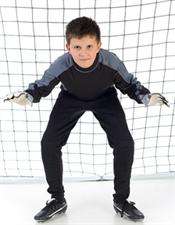Prevent Injuries by Preparing Kids to Get Back in the Game

(PhysOrg.com) -- With the beginning of school comes the beginning of school sports seasons. This fall, make sure children and teenagers are prepared to get back in the game with an awareness of the risks and the necessary training to exceed. And some sports may need a little extra vigilance.
“Soccer injuries are probably the most frequent for us here in Rochester, although hockey is a close second,” according to Anne Brayer, M.D., associate professor of Emergency Medicine at the University of Rochester Medical Center (URMC) and director of Injury Free Coalition for Kids of Rochester, based out of URMC’s Golisano Children’s Hospital. “Soccer injuries account for the most emergency visits to Golisano Children’s Hospital of any sports injuries each year. While the high rate of soccer injuries probably correlates with higher participation rates, it is still important to keep prevention strategies in mind.” Head injuries, knee injuries, and Sever’s Disease (heel pain) are the most common soccer injuries. Brayer recommends teaching kids to:
Know their size
Player collisions lead to about half of all soccer injuries, including head injuries, falls and even human bites. Kids are constantly getting stronger and bigger; and they’re all doing it at different rates.
A regular exercise routine is one of the best ways young athletes can get to know their bodies and limitations. Muscle fatigue occurs more easily when children and teenagers come into a season without having trained regularly, which increases the risk of injury.
Know when to stop
Head injuries are very common in soccer, due mainly to collisions. “Removal from play is very important after a head injury to prevent Second Impact Syndrome,” emphasized Brayer. This happens when a player has a second head injury during the recovery period from the first concussion. Even if the second injury is minor, the consequences can be severe and even fatal. Some studies suggest that up to two-thirds of catastrophic head injuries in sports, including permanent brain injury or death, occur in athletes who have had a previous head injury in the same season.
If not completely restricted, adult supervisors should set a limit on how frequently kids head soccer balls. “Scientific data is somewhat conflicting in terms of the risks of heading the ball at young ages. But it certainly seems to me that it makes sense to restrict repetitive trauma to growing brains,” said Brayer.
Another serious overuse injury is called Sever’s disease, which is heel apophositis, from the chronic pull of the Achilles tendon on the calcaneous (heel). Players can consult their coach for suggestions on running posture, conditioning the ACL, decreasing pull on the Achilles tendon and strengthening hamstrings and gluts.
Know their surroundings
Players also need to make sure they are following the rules of the game. Sports players can significantly decrease the likelihood that they will get hurt by knowing and abiding by the rules of the sport. Make sure that adult supervision is adequate and that coaches or supervisors have a commitment to safety.
Young athletes should always wear appropriate protective gear and equipment. For example, make sure that kids playing soccer have comfortable cleats, the right-sized ball, and shin guards. Injuries to mouth and eyes can be reduced with mouth guards and safety glasses. All jewelry should also be removed.
For more information on how to prevent sports-related injuries in young athletes, consult a sports adult supervisor or your physician.
Provided by University of Rochester (news : web)















